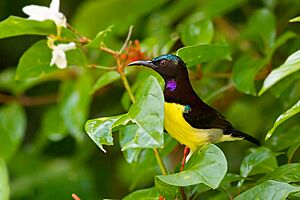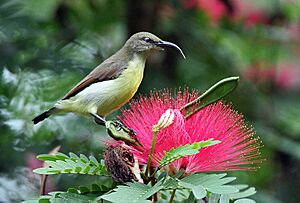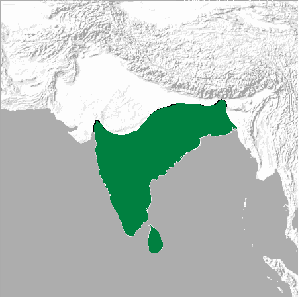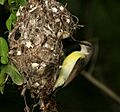Purple-rumped sunbird facts for kids
The purple-rumped sunbird (Leptocoma zeylonica) is a small, colorful sunbird found only in the Indian Subcontinent. These tiny birds are known for their bright colors and their love for nectar. They are similar to hummingbirds because they feed on nectar, but they usually perch on flowers instead of hovering for a long time.
Quick facts for kids Purple-rumped sunbird |
|
|---|---|
 |
|
| Male | |
 |
|
| Female on Calliandra, note the whitish throat | |
| Conservation status | |
| Scientific classification | |
| Genus: |
Leptocoma
|
| Species: |
zeylonica
|
 |
|
| Distribution of purple-rumped sunbird | |
| Synonyms | |
|
|
Purple-rumped sunbirds build a unique hanging nest that looks like a small pouch. It is made from cobwebs, lichens, and plant bits. Males and females look quite different. Males have bright, contrasting colors, while females are more olive-green and yellow. You can easily tell a male purple-rumped sunbird from a purple sunbird because the purple-rumped male has a light-colored belly. Females can be identified by their whitish throats.
Contents
What Do They Look Like?
Purple-rumped sunbirds are very small, usually less than 10 centimetres (4 in) long. They have thin, curved beaks that are perfect for reaching deep into flowers. Their tongues are like tiny brushes, helping them to lap up nectar.
Male and Female Differences
Male and female purple-rumped sunbirds look different, which is called sexual dimorphism.
- Males: They have a dark maroon back and a shiny blue-green crown on their head. They also have bright green patches on their shoulders and a violet or purple patch on their rump (lower back), which is often hidden by their wings. Their belly is whitish, but they have a dark throat and a maroon band across their chest. Sometimes, a purple patch on their throat can be seen. Their eyes are usually reddish.
- Females: They have a white throat that leads to a yellowish chest. Their upper body is olive or brownish. They have black feathers on their upper tail and sometimes a faint light stripe above their eye.
In some areas, these sunbirds might be seen with crimson-backed sunbirds. However, male crimson-backed sunbirds have redder backs and a wider chest band.
Their Call
These birds make a sharp, twittering sound. Their calls often sound like ptsiee ptsit or tityou, titou, trrrtit, tityou....
Where Do They Live?
The purple-rumped sunbird is a common bird in southern India, Sri Lanka, and Bangladesh. They live in many different places where there are trees, like gardens, farms, and scrublands. You usually won't find them in very dense forests. They have recently started to appear in new areas, like Gujarat in western India.
Their Daily Life and Reproduction
Purple-rumped sunbirds can breed throughout the year, but they are most active during the monsoon season. They might have two sets of babies in a year.
Building a Nest
The female sunbird builds the nest all by herself. The nest is made from thin plant fibers and cobwebs. She decorates the outside with lichens, small pieces of bark, and even flying seeds. The inside of the nest is lined with soft materials, like the fluffy fibers from Calotropis seeds. The nest hangs from the end of a branch, and its opening usually faces a bush. Sometimes, they even build nests near houses or under open porches.
Eggs and Chicks
The female lays two eggs, which are usually oval-shaped and pale greenish-white with spots and streaks. Sometimes, the eggs can be plain gray. Both the male and female take turns sitting on the eggs to keep them warm. This takes about 14 to 16 days. Once the chicks hatch, they stay in the nest for about 17 days. After they leave the nest, the male continues to feed them for a few more days. Sometimes, other birds, like young birds from a previous brood, might help the parents feed the babies. Old nests are sometimes used again.
Feeding Habits
Purple-rumped sunbirds help many plants by pollinating their flowers. This means they carry pollen from one flower to another as they drink nectar. They visit flowers from plants like Bruguiera, Woodfordia, and Hamelia. They usually perch on a flower while feeding, rather than hovering like some other sunbirds.
Sometimes, if a flower is too deep, they might poke a hole at the base of the flower to get the nectar. This is called "nectar theft" because they get the nectar without helping the flower with pollination. They also sometimes visit farm fields to eat honeydew, a sweet liquid produced by tiny insects called leafhoppers.
Other Interesting Behaviors
These sunbirds sometimes take "dew-baths." This is when they slide over drops of rain that have collected on large leaves to clean themselves.
Gallery






